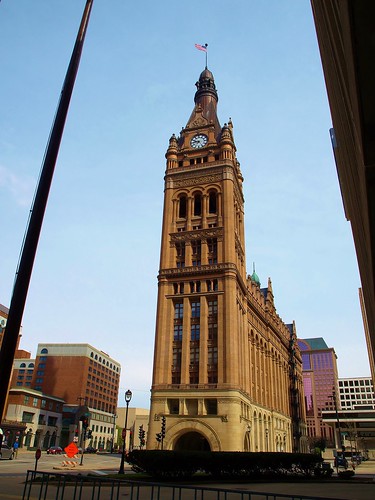P5080964
The clock tower of the Milwaukee City Hall fronts the majestic Flemish Renaissance Revival style building that stands on a narrow wedge of land between Water (left) and Market Sts, with Wells St cutting across the front, downtown Milwaukee, WI.
Milwaukee City Hall was designed by architect Henry C. Koch and built between 1891 and 1895. The foundation consists of 2,584 white pine piles that were driven into the marshy land surrounding the Milwaukee River. The building required eight million bricks, weighs approximately 41,000 tons, has more than 47,000 sq. feet of mosaic and marble flooring, and features approximately 107,000 sq. feet of office and meeting space. The building was one of the first to feature an extensive open atrium, of 20 by 70 feet, rising eight stories in the building’s centre. The building measures 393 feet from the base of the bell tower to the top of the flagpole, making it Milwaukee’s sixth largest. It was Milwaukee’s tallest building until completion of the First Wisconsin Center in 1973. The upper part of the tower was rebuilt after a fire in October 1929. The 22,500 pound bell – named "Solomon Juneau" after Milwaukee’s first mayor – was fabricated from melted copper and tin from old church and firehouse bells around the City, and was hoisted to the tower in 1896, first chiming on New Year’s Eve. While Milwaukee’s Allen-Bradley building (Rockwell Automation) features the world’s second largest four-sided clock, City Hall’s 18-foot clock was believed to be the world’s third largest when it was fabricated.
City Hall was the marketing symbol of Milwaukee until the completion of the Calatrava wing of the Milwaukee Art Museum in 2001, but the bell tower continues to be used as a municipal icon and in some traffic and parking signs. Formerly the tower had a Welcome Milwaukee Visitors message on the front three sides; this was one of the iconic images of the opening sequence for locally-set "Laverne & Shirley" television program.
From 2006 to 2008, the entire building was renovated, including a complete dis-assembly and reassembly of the bell tower. Before the restoration began, the bell was rung rarely because of seismic concerns, and in the last few years an assembly of scaffolds with protective coverings had been in place around the building to protect pedestrians from falling stone and brickwork.
Posted by gloriazvillis on 2017-07-16 09:10:01
Tagged:
Advertise your bike business at Bikes n Customs
#bikesncustoms
